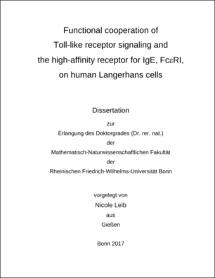Leib, Nicole: Functional cooperation of Toll-like receptor signaling and the high-affinity receptor for IgE, FcεRI, on human Langerhans cells. - Bonn, 2018. - Dissertation, Rheinische Friedrich-Wilhelms-Universität Bonn.
Online-Ausgabe in bonndoc: https://nbn-resolving.org/urn:nbn:de:hbz:5n-49568
Online-Ausgabe in bonndoc: https://nbn-resolving.org/urn:nbn:de:hbz:5n-49568
@phdthesis{handle:20.500.11811/7488,
urn: https://nbn-resolving.org/urn:nbn:de:hbz:5n-49568,
author = {{Nicole Leib}},
title = {Functional cooperation of Toll-like receptor signaling and the high-affinity receptor for IgE, FcεRI, on human Langerhans cells},
school = {Rheinische Friedrich-Wilhelms-Universität Bonn},
year = 2018,
month = jan,
note = {Atopic dermatitis (AD) is a multifactorial severe skin disease with increasing incidence in western countries. In the disease, Langerhans cells (LC) play a pivotal role in bridging innate and adaptive immunity through sensing invading pathogens by pattern recognition receptors (PRR) like Toll-like receptors (TLR) and presenting them to naïve T cells. A hallmark of skin LC of atopic individuals is the expression of the high-affinity receptor for IgE, FcεRI.
The aim of this study was to shed light on the regulatory mechanisms involved in FcεRI expression on activated human LC. Therefore, CD34 positive hematopoietic stem cell-derived LC (CD34LC) were used for stimulation assays with TLR ligands as well as with heat-killed Staphylococcus aureus (S.a.) and Streptococcus pyogenes (S.p.) to mimic the pathogens and the commensals colonizing human skin. Stimulation of CD34LC with all ligands resulted in a significant downregulation of FcεRI. Analysis of the factors promoting the expression of FcεRI revealed that the main transcription factor PU.1 and the less expressed transcription factors Yy1, Elf-1, Hmgb1 and Hmgb2 were significantly downregulated upon activation of the cells with the ligands used here.
Since PU.1 was the strongest expressed transcription factor in CD34LC, its regulation was further investigated. PU.1 is inter alia controlled by microRNA-155 (miRNA-155), a miRNA that is induced in macrophages and DC upon activation. The expression of miRNA-155 was examined and, additionally, CD34LC were transfected with pre-miRNA-155 molecules to confirm the effect of those miRNA on the expression of FcεRI. In summary, a high induction of miRNA-155 was observed under all stimulation conditions followed by a decrease of PU.1, which was further confirmed by ectopic miRNA-155. In line with PU.1 downregulation, FcεRI expression also decreased with all stimuli and with ectopic miRNA-155, too.
Another important immunological miRNA is miRNA-146a, which is expressed constitutively on LC and facilitates endotoxin-induced tolerance. miRNA-146a analysis was included in this study to check a putative involvement of this miRNA in the regulation of FcεRI expression. In contrast to miRNA-155, miRNA-146a was only weakly induced upon stimulation of CD34LC. Additionally, no effect of ectopic miRNA-146a on FcεRI expression was detected.
In conclusion, the results of this thesis revealed a regulatory network between TLR and FcεRI involving the TLR-dependent induction of miRNA-155, which in turn controls the translation of PU.1 and in succession the expression of FcεRI.},
url = {https://hdl.handle.net/20.500.11811/7488}
}
urn: https://nbn-resolving.org/urn:nbn:de:hbz:5n-49568,
author = {{Nicole Leib}},
title = {Functional cooperation of Toll-like receptor signaling and the high-affinity receptor for IgE, FcεRI, on human Langerhans cells},
school = {Rheinische Friedrich-Wilhelms-Universität Bonn},
year = 2018,
month = jan,
note = {Atopic dermatitis (AD) is a multifactorial severe skin disease with increasing incidence in western countries. In the disease, Langerhans cells (LC) play a pivotal role in bridging innate and adaptive immunity through sensing invading pathogens by pattern recognition receptors (PRR) like Toll-like receptors (TLR) and presenting them to naïve T cells. A hallmark of skin LC of atopic individuals is the expression of the high-affinity receptor for IgE, FcεRI.
The aim of this study was to shed light on the regulatory mechanisms involved in FcεRI expression on activated human LC. Therefore, CD34 positive hematopoietic stem cell-derived LC (CD34LC) were used for stimulation assays with TLR ligands as well as with heat-killed Staphylococcus aureus (S.a.) and Streptococcus pyogenes (S.p.) to mimic the pathogens and the commensals colonizing human skin. Stimulation of CD34LC with all ligands resulted in a significant downregulation of FcεRI. Analysis of the factors promoting the expression of FcεRI revealed that the main transcription factor PU.1 and the less expressed transcription factors Yy1, Elf-1, Hmgb1 and Hmgb2 were significantly downregulated upon activation of the cells with the ligands used here.
Since PU.1 was the strongest expressed transcription factor in CD34LC, its regulation was further investigated. PU.1 is inter alia controlled by microRNA-155 (miRNA-155), a miRNA that is induced in macrophages and DC upon activation. The expression of miRNA-155 was examined and, additionally, CD34LC were transfected with pre-miRNA-155 molecules to confirm the effect of those miRNA on the expression of FcεRI. In summary, a high induction of miRNA-155 was observed under all stimulation conditions followed by a decrease of PU.1, which was further confirmed by ectopic miRNA-155. In line with PU.1 downregulation, FcεRI expression also decreased with all stimuli and with ectopic miRNA-155, too.
Another important immunological miRNA is miRNA-146a, which is expressed constitutively on LC and facilitates endotoxin-induced tolerance. miRNA-146a analysis was included in this study to check a putative involvement of this miRNA in the regulation of FcεRI expression. In contrast to miRNA-155, miRNA-146a was only weakly induced upon stimulation of CD34LC. Additionally, no effect of ectopic miRNA-146a on FcεRI expression was detected.
In conclusion, the results of this thesis revealed a regulatory network between TLR and FcεRI involving the TLR-dependent induction of miRNA-155, which in turn controls the translation of PU.1 and in succession the expression of FcεRI.},
url = {https://hdl.handle.net/20.500.11811/7488}
}






